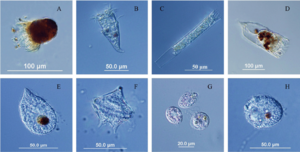Protozoa
Description:

Protozoans, an informal subfamily of protists, are single-celled animal-like eukaryote. This subgrouping of protists is highly paraphyletic and the organisms characterized as such do not necessarily share a common ancestor. Protozoans occupy a variety of environments, ranging from the South to the North Pole. They can be free-living, or form parasitic or symbiotic relationships with hosts. Protozoans are motile, heterotrophic organisms that exhibit animal like behaviors, such as predation. Body sizes range from 5 to 500 µm.
Life Cycle/Reproduction:
Protozoa are known to reproduce both asexually and sexually. Sexual reproduction is more rare among protozoa and asexual reproduction is more common. Asexual reproduction in protozoa includes binary fission, budding and spores. Among the sexual reproducers, amoeba are known to engage in process known as conjugation. This process involves the fusion of oral groves and the exchange of genetic data.
Locomotion:
Protozoa are motile organisms. They generally move by one of three different mechanisms; amoeboid action, ciliary action or flagella. Amoebic action involves the use of pseudopods, or false feet. The pseudopods are used to move the body forward through extension, followed by a flow through. Ciliary action involves the beating of many hair-like extensions. A flagellum acts as a whip to propel a protozoa, either through pushing or pulling.
In Soil:

Soil protozoans are comprised of four major groups: the flagellates, naked amoeba, testaceans, and ciliates. Each group has a distinctive body design and are classified based on their shape. As soil inhabitants, protozoans play an important role in mineralization of nutrients and increasing nutrient supply. Through grazing activity, protozoans stimulate decomposition, resulting in nitrogen excretion. The nitrogen is then bioavailable for plant uptake. As heterotrophs, protozoans rely on eating other organisms for nutrition. Some protozoans consume entire organisms, while others take up their waste products. Their feeding habits make protozoans an important component of regulating bacterial populations. Although it is not entirely understood, bacterial feeding stimulates bacterial growth.

Methods for Extraction:
Past methods for extraction focused heavily on culturing populations, but due to failure of some species to be cultured in a lab, this method is more rapidly being replaced by modern techniques. With advanced in genetic techniques, eDNA can now be amplified for use as an identifying tool. eDNA coupled with next generation sequencing has greatly aided in identifying and quantifying soil organisms that was previously unattainable with previous techniques.